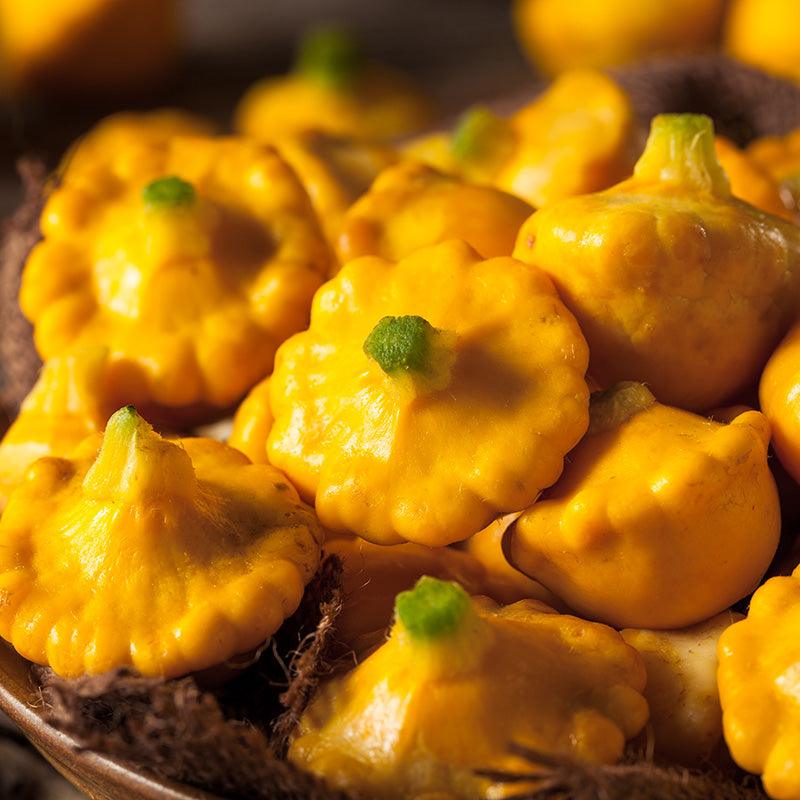Item Number: PV146
Organic Sunburst Squash
Scallop-Type Charm and a Delicate Buttery Flavor
A delightful butter-yellow patty pan squash showcases a scallop-type charm and a delicate buttery flavor. Adorned with a small dark green ring, each fruit boasts mild, white flesh that retains tenderness and firmness. Sunburst is early, productive, and an esteemed recipient of the All America Selections award. Optimal harvest is at a 3" diameter, around 50-55 days.
Sustainably grown in 2.75" pots
Preparing the Soil
Sunburst squash thrives in well-drained, fertile soil with a pH level between 6.0 and 7.0. Before planting, prepare the soil by loosening it to a depth of 8 to 12 inches and incorporating organic matter such as compost or aged manure. This will improve soil structure, fertility, and moisture retention, creating an ideal environment for sunburst squash to thrive.
Planting Sunburst Squash
Sunburst squash is a warm-season crop that requires plenty of sunlight to grow and produce fruit. Plant starts in late spring or early summer, once the soil has warmed up to at least 60°F (15°C). Space plants 2 to 3 feet apart in rows spaced 4 to 6 feet apart to allow for adequate air circulation and room for vine growth.
Watering and Care
Sunburst squash requires consistent moisture throughout the growing season to develop healthy foliage and fruit. Water the plants deeply once or twice a week, providing enough water to keep the soil evenly moist but not waterlogged. Avoid overhead watering, as wet foliage can promote fungal diseases. Mulching around the base of the plants can help retain soil moisture and suppress weeds.
Fertilizing
Sunburst squash is a heavy feeder and benefits from regular fertilization throughout the growing season. Apply a balanced fertilizer or compost tea every 3 to 4 weeks to provide essential nutrients for healthy growth and fruit development. Be sure to follow the manufacturer's instructions for application rates and timing.
Training and Support
Sunburst squash plants are vining and can spread out extensively in the garden. Consider providing support or trellising to keep the vines off the ground and prevent fruit rot. Pruning the vines as needed can also help improve air circulation and reduce the risk of disease.
Pest and Disease Management
Sunburst squash is susceptible to a variety of pests and diseases, including aphids, squash bugs, powdery mildew, and blossom end rot. Monitor your plants regularly for signs of pest infestations or disease symptoms and take appropriate action to control them. Use insecticidal soap or neem oil to treat aphids and squash bugs, and apply fungicides to prevent powdery mildew.
Harvesting Sunburst Squash
Sunburst squash is ready to harvest when the fruits reach a diameter of 2 to 4 inches and have a bright yellow color. Use a sharp knife or pruning shears to cut the squash from the vine, leaving a short stem attached. Harvest regularly to encourage continued fruit production throughout the growing season.
Growing sunburst squash can be a rewarding experience that allows you to enjoy delicious and nutritious squash right from your garden. By following the tips and guidelines outlined in this guide, you can successfully cultivate sunburst squash and enjoy a bountiful harvest of vibrant and flavorful fruits all summer long.




Check Your Zone Compatibility:
Compatible with your zone.
Growing Zone for

Our Guarantee To You
Since 1976, we've served our customers at every stage of growing. Please contact us at any time. We are happy to support and assist you.
Shipping Information
Shipping Information
Cannot ship to the following states: AK, HI, PR, VI, GU
Shipping Weight: 0.5 lb
Features
Features
- Bush
Characteristics
Characteristics
Planting & Care
Planting & Care
Soil & Water: Provide squash plants with deep mounds of organic matter, rich soil, and heavy, even water. All squash are extremely frost sensitive, so use mulch to heat soils in early spring and row covers to protect from frost at both ends of the growing cycle, especially in short growing seasons.
Planting & Growing: Plant starts in late spring or early summer, once the soil has warmed up to at least 70°F (21°C). Space plants 2 to 3 feet apart in rows spaced 4 to 6 feet apart to allow for adequate air circulation and room for vine growth. Place a board underneath the fruit to help prevent rotting.
Harvesting & Storage: Pick squash when they are 3" in diameter to keep production high, and for the best flavor.
Useful Information
Useful Information
Guarantee
Guarantee
We guarantee the perishable items we sell to be in good, viable condition when we sell them. Perishable items include, but are not limited to, garlic bulbs, flower bulbs, seed potatoes, onion sets & transplants, potted or bare root trees, vegetable crowns, etc. If your perishable item arrives in substandard condition, take photographs and please contact us within 3 days of the purchase date (or delivery date) and we will provide you with a refund of the purchase price (excluding shipping costs), or a replacement. Accordingly, we urge you to open any boxes marked as ""Perishable"" immediately upon receiving them and inspect the shipment thoroughly (do not crack open heads of garlic, we do not accept claims on cracked garlic). Because some perishable items can deteriorate very quickly, we cannot accept any claims beyond the 3-day time frame as it becomes too difficult to determine if these items were delivered in substandard condition, or if they turned into such substandard condition because of having been improperly cared for or stored once delivered.
Share


